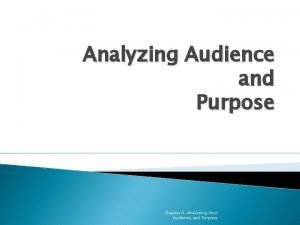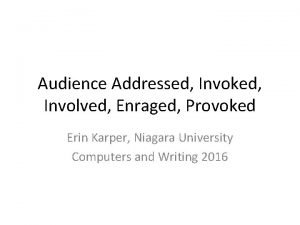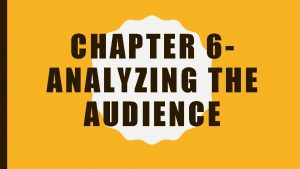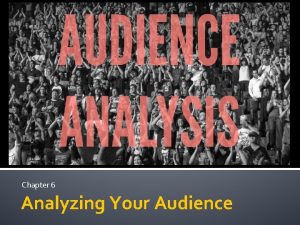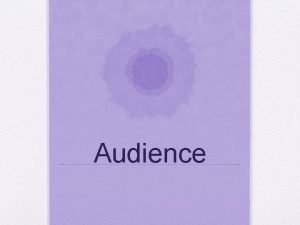CHAPTER 6 ANALYZING THE AUDIENCE AUDIENCECENTEREDNESS Audiencecenteredness Keeping







- Slides: 7

CHAPTER 6 ANALYZING THE AUDIENCE

AUDIENCE-CENTEREDNESS • Audience-centeredness: Keeping the audience foremost in mind at every step of speech preparation and presentation – Objective is to gain a desired response from the listeners • Do not have to compromise your beliefs • Do not have to use unethical tactics to achieve your goal

AUDIENCE-CENTEREDNESS • Keep in mind these questions to be audience centered: – To whom am I speaking? – What do I want them to know, believe, or do as a result of my speech? – What is the most effective way of composing and presenting my speech to accomplish that aim?

YOUR CLASSMATES AS AN AUDIENCE • The best classroom speeches are those that take the audience as seriously as a lawyer, politician, or advertiser takes an audience

THE PSYCHOLOGY OF AUDIENCES • The speaker must make the audience choose to pay attention • Every speech contains 2 messages: – One sent by the speaker – Once received by the listener • What the speaker says is filtered through the listener’s frame of reference • Listeners want to hear about things that are meaningful to them – Egocentrism: The tendency of people to be concerned above all with their own values, beliefs, and well-being • How does this affect you as a speaker? – Listeners will hear and judge based on what they already know and believe – You must relate your message to your listeners

DEMOGRAPHIC AUDIENCE ANALYSIS • Demographic audience analysis: Audience analysis that focuses on demographic factors such as age, gender, religion, sexual orientation, group membership, and racial ethnic or cultural background • There are two steps of demographic audience analysis: – Identifying the general demographic features of your audience – Gauging the importance of those features to a particular speaking situation • When used improperly, it can lead to stereotyping – Stereotyping: Creating an oversimplified image of a particular group of people, usually by assuming that all members of a group are alike

DEMOGRAPHIC AUDIENCE ANALYSIS • Consider the following demographic factors: – Age • Speaking to an older audience vs. a younger audience – Gender • Take in current gender attitude and practices • Be aware of both gender differences and similarities • Avoid generalizations – Sexual Orientation • Be mindful of language, examples, and other elements that may exclude listeners with same-sex partners – Racial, Ethnic, and Cultural Background • Some listeners may have perspectives that will affect how they are listening to the speech – Group Membership • Knowing the groups or memberships you audience is in may give excellent clues about your listeners interests and attitudes



